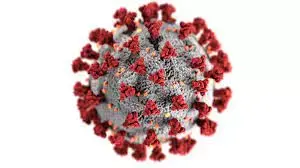Summarized to 2 minutes: Back in the 1930s and 40s there was some research done on particulate matter in coal mines that found that particles above 5 microns (0.005 mm) were consistently caught by the nose and throat, while smaller ones passed through to cause damage to the lungs. This boundary ended up being widely cited and used in convenience for more broad purposes concerning any particulates suspended in the air.
Around that same time, a doctor/engineer couple had submitted research suggesting that 100 microns was the threshold for quickly falling out of the air, and that many pathogens smaller than this, like tuberculosis and measles and influenza, could travel longer distances through the air. A prominent scientist shot down the idea because it sounded like miasma theory (aka "noxious humors"). For the rest of the 20th century, medical authorities commonly treated <5 microns as a buoyant aerosol, and >5 microns as a falling droplet.
In spring 2020, the WHO was rejecting the expertise of a physicist in aerosols, with the organization claiming that airborne particles had to be <5 microns. For public health purposes, if the pathogen is in droplets you wash the surfaces it can land on (including hands) and if it's in an aerosol you filter your air, both in an area and at the point of respiration.
A cross-disciplinary researcher in medicine and engineering, and several of her contacts, tracked down the citation trail and context, piecing together the story of where things had gone wrong over half a century prior. Eventually the WHO admitted quietly that SARS-CoV-2 virions can be aerosolized as well as traveling in droplets. But they'd already stood by the 6-foot rule based on droplets, which they had favored over masking rules, and didn't retract it despite it being proven to be a hazardously incomplete model. This, combined with not educating people on how Covid is airborne as well as on surfaces, resulted in the confusion and uncertainty that exacerbated the first year of the virus. The only people who became any safer are the people who followed the practice of a prescient Chinese university professor, giving extra ventilation to more crowded indoor areas.
This is also a good example of how the scientific establishment can often take shortcuts, make mistakes, and then double down on those mistakes.
Good summary. I'd like to clarify that the source of the original confusion was the 100 micron threshold for falling out of the air being conflated with the 5 micron threshold of tuberculosis infection decades ago. So the WHO believed SARS-CoV-2 droplets would fall onto surfaces because they were larger than 5 microns, but in actual fact they would remain suspended in the air. That's why preventative mask advice only became well-known several months into the pandemic.
Whatever it takes to get
 seated with unlimited refills at the Golden Corral!
seated with unlimited refills at the Golden Corral!I hadn't seen it--thanks for sharing! I honestly had no idea that the airborne-droplet dichotomy went so far beyond the issue of SARS-CoV-2 classification. Yet more evidence for how this pandemic should have been a catalyst for drafting new standards for indoor air quality supported by massive subsidies for the necessary equipment.





